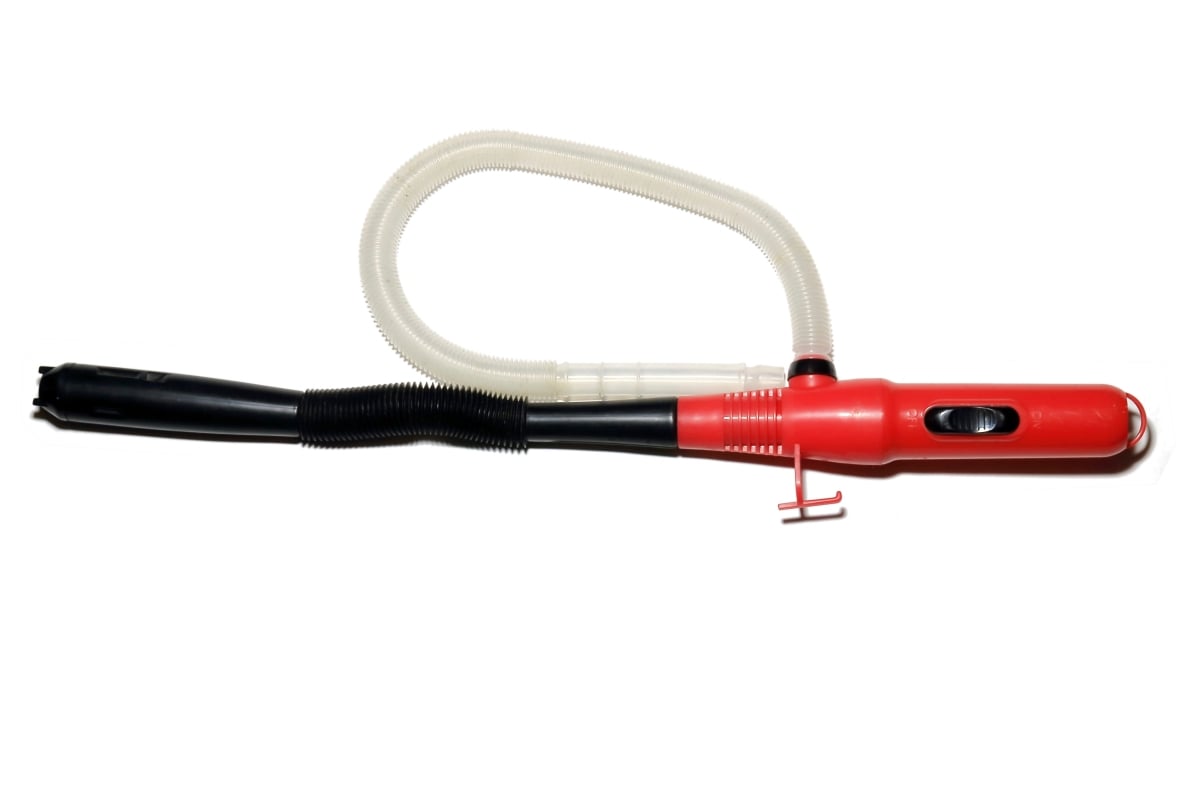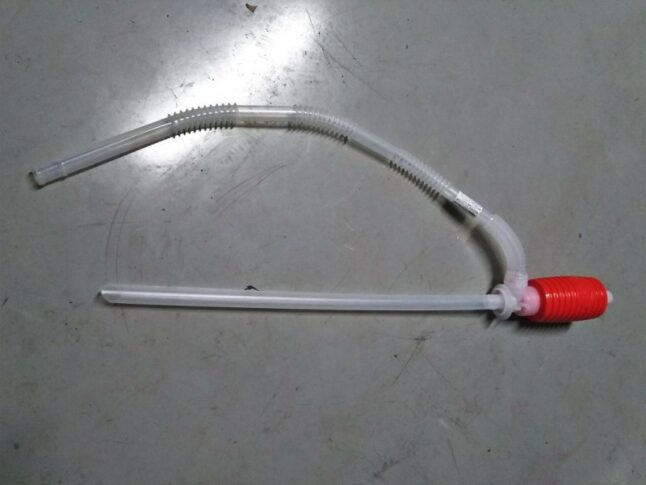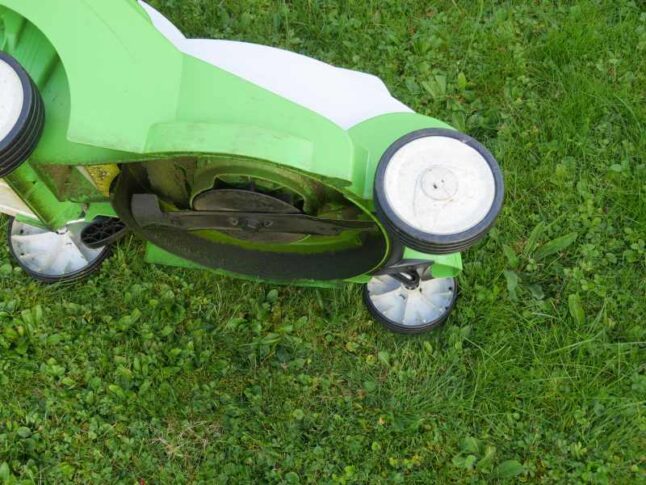
Draining gas from a lawn mower engine is a simple chore that can save you from carburetor problems later on, whether you’re preparing to store the mower for winter or just want to give your mower a fresh start. In this article, we’ll lead you through the simple process of how to drain gas from a lawn mower. Let’s roll up our sleeves and get that engine ready for action!
How To Drain Gas From a Lawn Mower With a Siphon Pump

One of the most popular ways to empty a lawn mower’s gas tank is by siphoning the gas. Siphoning is a technique that involves using a siphon pump to start the flow of gas from the mower’s tank into a separate gas container. If you want to drain the gas from your lawn mower’s tank using a siphon, follow this step-by-step procedure.
Step 1: Unplug the Spark Plug Wire
Set up your lawn mower on a flat, steady surface. Then, disconnect the spark plug wire to avoid accidents.
Step 2: Gather Supplies
Have your siphon pump, gasoline container, and pliers (if needed) ready and within reach.
Step 3: Access the Lawn Mower’s Gas Tank
Locate the gas tank on your lawn mower. It’s usually located near the engine or under the hood. If there’s a fuel shutoff valve, turn it to the “off” position.
Step 4: Drain the Gas Using Siphon Pump
Open the mower fuel tank by removing the cap. Insert the intake or longer siphon pump hose into the gas tank. Ensure it’s submerged in the gasoline but not touching the bottom of the tank to avoid collecting sediment.
Put the bottom or shorter hose of the siphon pump into the empty gasoline can to collect the old gas. Hold the gas can lower than the gas tank to allow gravity to help with the flow. Begin pumping the siphon pump to start the gas flowing through the hose.
Step 5: Empty the Gas Tank
Continue siphoning until the gas tank is empty. Depending on the size of the fuel tank and the siphon pump’s flow rate, this might take a few minutes. Gently shake the siphon to remove all the drops of gas, then detach the pump from the gas can and mower. Wipe up any spills or drops, and make sure the gas tank and the surrounding area are dry.
Step 6: Reconnect the Spark Plug Wire
Reconnect the spark plug wire and start your lawn mower. To completely dry out the old gas, keep the engine on and let the residual gas burn out. Your lawn mower is now safe to store for the off-season.
Note: Along with draining gas from the lawn mower, preparing your lawn mower for winter includes the following tasks:
- Sharpening the lawn mower blades so they’re ready for next spring
- Draining or changing the mower’s engine oil
- Checking and changing the spark plugs if they need it
- Cleaning or replacing the air filter as needed
- Cleaning the mower’s underside one last time (you should also clean the underside regularly throughout the season)
How To Drain Gas From a Lawn Mower Without a Siphon Pump

If you want to drain gas from a lawn mower without using a siphon pump, there are three options available for you:
- Manual Tilting
- Using a Funnel
- Disconnecting Fuel Line
Manual Tilting
With this method, you simply tilt the lawn mower on its side to drain the gas. Here’s how to do it.
How to drain lawn mower gas with manual tilting:
- Place the mower on a level surface and disconnect the spark plug.
- Look for a gas cap on the gas tank and take it off.
- Place a draining pan or a container to collect the gas underneath the mower.
- Gently tilt the mower towards the gas tank’s opening, directing the gas towards the draining container below.
- Hold the mower in this tilted position until the gas tank is empty.
- Carefully return the mower to an upright position once you are done with draining. Reconnect the spark plug wire and run the mower to burn off any remaining gas.
Using a Funnel
A funnel can help guide the gas flow into a container, especially if the gas tank’s opening is large.
How to drain lawn mower gas with a funnel:
- Set the mower on a flat surface and disconnect the spark plug wire.
- Position a funnel securely over the gas tank’s opening.
- Open the gas cap.
- Place a container below the funnel to collect the gas.
- Tilt the mower slightly to help the gas flow into the container through the funnel.
- Keep tilting until the gas tank is empty.
- Reconnect the spark plug wire and run the mower to burn off any remaining gas.
Disconnecting Fuel Line
With this method, you disconnect the fuel line from the carburetor to drain the gas. This method requires caution and should only be attempted if you’re comfortable working with fuel systems.
How to drain lawn mower gas by disconnecting the fuel line:
- Set up your lawn mower on a flat, even working space, and disconnect the spark plug wire before you do anything else.
- Locate the fuel line connecting the gas tank to the carburetor.
- Carefully disconnect the fuel line from the carburetor.
- Place a draining container or pan below the disconnected fuel line.
- Allow the gas to drain from the fuel line into the container.
- Reconnect the fuel line after the gas tank is empty. Also, reconnect the spark plug wire, then run the mower to burn off any remaining gas.
When To Drain Gas From a Lawn Mower
You should drain the gas from your lawn mower at the end of every mowing season. Additionally, it is wise to replace or empty the gas to prevent any mechanical or technical problems in the following situations:
- Before storing or transporting the mower for an extended period of time
- If you use ethanol-blended fuel
- If the fuel is changing color
Why is it Important to Drain Gas From a Lawn Mower?
Over time, gasoline becomes contaminated with dirt, dust, and moisture. When your mower sits idle for a long time, the volatile components of gasoline can evaporate, leaving behind a gummy residue that can clog fuel lines, filters, and carburetors. This residue doesn’t just slow down your mower; it can lead to hard starts, sputtering performance, and even compressor damage.
When you refuel your mower with fresh gas at the beginning of every season, you ensure a smoother combustion process and an effective start when you roll the mower back out next spring. In short, draining gas isn’t just about saying goodbye to old gas; it’s about safeguarding your mower engine’s vitality and ensuring its optimal performance for years to come.
FAQ About Draining Gas From a Lawn Mower
Can I leave gas in the mower if it has an ethanol-free fuel option?
Even if your mower uses ethanol-free fuel, it’s still advisable to drain the tank or use a fuel stabilizer for long-term storage. Ethanol-free gas can also degrade over time and lead to starting problems.
What are the risks of leaving old gas in the mower’s tank?
Old gasoline can clog the carburetor, degrade over time, and lead to engine damage.
Can I use a fuel stabilizer instead of draining the gas?
Although a fuel stabilizer is suitable for small engines to prevent fuel deterioration, draining is still recommended for more extended storage periods. Typically, 1 ounce of stabilizer treats 2.5 gallons of gas.
Final
How a Lawn Care Pro Can Help
Draining gas from the engine is a crucial part of routine lawn mower maintenance, ensuring the engine’s reliability and longevity. Stale or old gasoline can lead to starting problems, engine damage, and other fuel system issues.
Many homeowners with busy lives find it challenging to keep up with regular lawn mower maintenance, not to mention actually mowing the lawn every week.
If you’re among those homeowners who would rather spend their free time relaxing with friends and family than sweating in the lawn or garage, reach out to a local lawn care pro through LawnStarter today! LawnStarter is a convenient online platform that connects you with licensed, insured, and background-checked small lawn care businesses in your neighborhood.
Main Photo Credit: kudou / Canva Pro / License